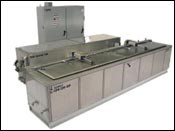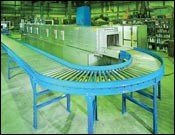Building Blocks of an Aqueous Cleaning Process
Chemistry, time, temperature and mechanical energy are the keys
Many manufacturers are feeling additional pressure to supply a higher level of part cleanliness to their end users. Cleanliness levels that were acceptable in the past may no longer suffice. Machined part and assembly tolerance are getting tighter and more difficult to achieve without addressing the finishing process that nowadays always includes cleaning.
Selection of the correct aqueous cleaning process should always start with a thorough understanding of the contamination that is on the parts as they are presented to the proposed cleaning system. The manufacturing engineer should have documented all the preceding processes the part has been exposed to, along with any other related manufacturing processes.
Building Blocks
The basic building block elements that make up any aqueous cleaning process will always consist of thermal, chemical and mechanical energies along with dwell time. The old image of the cleaning triangle, with these three energies at the corners and time in the center, simply states that if you increase one form of energy, you can typically reduce the other two forms of energy.
An example of this could be applied to the removal of aluminum oxide from a thermally deburred aluminum part. Increasing the part’s exposure to a high amount of mechanical energy, for example ultrasonics, greatly accelerates an acidic reaction. This might allow a reduction in the temperature and concentration of the acidic de-oxide solution. Finding the correct balance of these energies for the application is the answer to the cleaning equation.
When looking at a new aqueous cleaning process, it’s important to have adequate, reliable lab work completed by more than one qualified vendor, and to have the process proven. Most aqueous cleaning equipment manufacturers have an applications laboratory that can clean your samples and help develop a cleaning process at no charge.
An applications survey questionnaire should be completed and accompany the representative sample parts to the lab. This survey provides the lab technician with critical information that will help determine the best way to process the sample parts. Throughput requirements, critical surfaces, final part cleanliness, debit audit procedures, and incoming part soil loading all effect how the sample parts should be processed and which type of equipment is best suited to fit the application.
If the lab work is manipulated to yield acceptable results, the integrity of the premise behind the final cleaning process is flawed, leading to a compromised final cleaning system. Therefore, the more thoroughly and accurately a manufacturer can convey this survey information, the better for all parties.
Knowing what processes a part has seen provides an invaluable insight for the cleaning equipment manufacturer. Almost any cleaning application has been previously solved, and a knowledgeable engineer probably has that history. The open issues will remain the obvious—capital costs, material handling, and floor space constraints.
If the project is of any magnitude, most cleaning equipment manufacturers welcome potential customers to visit and see first-hand the second round of lab cleaning trials. It is also essential that cleaning supplier’s engineer visit the customer facility and confirm all aspects of the proposed project prior to an order.
In these days of tighter capital equipment budgets, it’s become imperative that customers get the most cleaning system for their money. However, purchasing the lowest capital cost system does not necessarily equate to the lowest total cost of ownership over the lifetime of the piece of equipment. If a piece of equipment is going to be used on a critical, high-use basis as opposed to limited usage, then the benefit of robust equipment with long-term reliability will probably outweigh initial capital savings.
Chemistry
When starting development of an aqueous cleaning process, the chemistry should typically be the first consideration. Part material and contamination will dictate what range of pH is tolerable for the application. Aqueous chemistry can range from highly acidic, with a pH of 1, to near neutral, to highly alkaline, with a pH of 14. The balancing act is to use the least amount of chemistry at the lowest temperature with the least costly form of mechanical energy to achieve the necessary results in the required time cycle.
The basic rule remains to use alkaline chemistries to remove organic contaminants, such as oils, greases, coolants and animal fats, and to use acidic chemistries to remove inorganic contaminants, like oxides. Neutral cleaning chemistries can be excellent when used to accompany systems that supply relatively high mechanical energy, such as ultrasonics. Reactive metals such as copper, brass and aluminum alloys can tolerate only slightly alkaline or acidic chemistries before the material is attacked.
Some chemistries include built-in inhibitors that limit the amount of aggressiveness the chemistry will have toward these types of metals. The softer, reactive metals are also prone to physical damage from mechanical and thermal energies that are applied in the cleaning process. Tarnishing or discoloration from too high a solution bath temperature can occur depending on the various alloys of these metals.
And, relatively small changes in process temperature can have a big impact on cleaning aggressiveness. Raising the solution temperature by 10°C, for example, will typically double the chemical reaction.
Less reactive metals are candidates for stronger chemistries, higher solution temperature and increased mechanical energy. A steel part can withstand high temperatures and aggressive alkaline detergent used to remove organic or inorganic contaminants, such as carbonized oils. The more chemical inert a contaminant is, the more it warrants the use of mechanical energy to drive the chemistry underneath the contamination and allow the solution to break the molecular bond to the part substrate.
Knowing the true soil loading of the first wash stage will determine if additional capacity is required. High oil loads warrant, as a minimum, a two-stage wash process with the first stage (prewash) capable of removing the majority of the oils. In this application, the prewash stage should be equipped with an oil removal system to limit re-deposition of oil back on the parts before their transfer to the final wash stage. Oil removal systems range from simple belt, tube or wheel skimmers to coalescing packages with polypropylene media to thin-film, airfoil-type separators.
Which system is the correct choice for the application depends on many variables. In most cleaning applications that require removal of organics, an oil removal package adds real benefit by extending chemistry life, reducing carry-over and lowering rinse water usage requirements.
Thermal Energy
The second building block of an aqueous cleaning process is thermal energy—not only how much heat is applied, but how it’s applied. As you narrow your decision on the type of aqueous cleaning process that will best fit your application, pay attention to the type, quality and capacity of the heating elements being offered by potential vendors. Only in the smallest of process tanks should bolt-on strip heaters be considered. These have inherent limitations with regards to service life and heating capacity. The resistive heat load is the main energy user with most aqueous cleaning systems, and having these heaters properly sized and controlled can have a substantial effect on electrical usage costs.
A better choice for most applications is immersion heating. Either over-the-side or screw-plug type immersion heaters should be selected to supply the proper power density (watts per square inch) for the application. Chemistry breaks down and heater life is reduced if these parameters are not followed.
For temperature control, digital temperature controllers with thermocouples should be strongly considered over dial thermostats. Digital units have displays that provide easy visual monitoring of solution temperature, and they also generally provide improved control of the dead band, which can extent both heater and contactor life.
When process or solution storage tanks exceed 400 gal capacity, steam or gas heating should be strongly considered. Cleaning systems that use relatively large amounts of energy, such as large in-line spray washers, are good candidates for non-electric heating.
Mechanical Energy
The final key piece of the aqueous cleaning process puzzle is mechanical energy, and the amount and type of mechanical energy supplied to the cleaning process depends on hardware selection.
One of the lower-cost hardware alternatives for a batch wash application is use of vertical agitators. Vertical agitators are used widely in pre-wash or cellular applications because of their tendency to be less affected by heavy oil loading. Tanks typically use a pneumatic cylinder with a work platform that forces the heated process fluid to flow in and around the parts as they are oscillated. The action of lifting the parts in and out of solution allows process chemistry to quickly dispel contaminants. Addition of a motor-driven propeller to roll the solution while the parts are vertically agitating creates additional solution movement and pressures to further flush away soils.
Spray under immersion is another form of turbulation that uses a recirculating pump and filter that discharges back into the tank to create increased directed solution movement. The addition of basket rotation to this system brings another level of mechanical impingement to the parts.
The next family of cost-effective cleaning systems is spray washers. A batch rotating cabinet washer can handle high soil loads, and is applicable in both cellular and pre-wash applications. Helical drum spray washers provide a very reliable mechanical means of transporting large volumes of product through the complete cleaning process, as long as the parts can tolerate some part-on-part contact. In-line or U-bend style belt spray washers can apply large amounts of mechanical energy to parts via impingement.
Multiple stages of washing, rinsing, rust inhibiting and drying are standard in spray-type washers. Positioning of the spray nozzles close to the work and use of pressures up to 200 psi or more can produce very consistent results. In-line spray washers lend themselves to a range of applications, from highly soiled automotive components to circuit board and precision optical applications.
The use of ultrasonics has the potential to deliver the highest degree of mechanical energy to the cleaning process. In so doing, ultrasonic cleaning technology can allow the process to run at lower temperatures and with a less aggressive chemistry. If the required level of part cleanliness can’t be achieved with the more conventional washing methods, use of ultrasonics should be explored.
Related Content
Calculating the Cost of Powder Coating
How can you calculate the cost of powder coating a component if you only know its surface area? Powder coating expert Rodger Talbert has the answer.
Read MorePowder Coating Overcomes Post Forming
Six Sigma methodology, open communication, and collaboration produce results for leading boat manufacturer.
Read MoreAn Altruistic Growth Strategy Puts People First
Professional Plating emphasizes investing in its team and fostering a supportive environment on the shop floor.
Read MoreProducts Finishing Reveals 2024 Qualifying Top Shops
PF reveals the qualifying shops in its annual Top Shops Benchmarking Survey — a program designed to offer shops insights into their overall performance in the industry.
Read MoreRead Next
Education Bringing Cleaning to Machining
Debuting new speakers and cleaning technology content during this half-day workshop co-located with IMTS 2024.
Read MoreDelivering Increased Benefits to Greenhouse Films
Baystar's Borstar technology is helping customers deliver better, more reliable production methods to greenhouse agriculture.
Read MoreA ‘Clean’ Agenda Offers Unique Presentations in Chicago
The 2024 Parts Cleaning Conference, co-located with the International Manufacturing Technology Show, includes presentations by several speakers who are new to the conference and topics that have not been covered in past editions of this event.
Read More













.jpg;maxWidth=300;quality=90)










